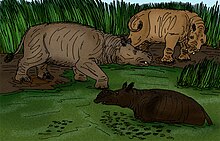Amynodontidae
| Amynodontids Temporal range:
| |
|---|---|

| |
| Scientific classification | |
| Domain: | Eukaryota |
| Kingdom: | Animalia |
| Phylum: | Chordata |
| Class: | Mammalia |
| Order: | Perissodactyla |
| Superfamily: | Rhinocerotoidea |
| Family: | †Amynodontidae Scott & Osborn, 1883[1] |
| Type genus | |
| †Amynodon | |
| Genera[2] | |
|
See text | |

| |
| Range of Amynodontidae based on fossil record | |
MHNT

Amynodontidae ("defensive tooth").
The Greek name of the family describes their tusks, derived from enlarged canine teeth. Odd-toed ungulates are herbivores, so these tusks would have been used either to deter or defend against predators (as suggested by the name) or perhaps in fights among males.[8]
Their fossils have been found in
Late Oligocene in South Asia (Pakistan).[9] The genus Metamynodon may have survived into the early Miocene.[citation needed
]
Taxonomy
†Amynodontidae
- Subfamily Amynodontinae
- Tribe Cadurcodontini
- Genus Cadurcodon[10]
- Genus Lushiamynodon[10]
- Genus Sharamynodon[10]
- Tribe Metamynodontini
- Genus Gigantamynodon[10]
- Genus Metamynodon
- Genus Paramynodon[10]
- Genus Zaisanamynodon[10]
- Tribe incertae sedis
- Tribe Cadurcodontini
- Subfamily incertae sedis
- Genus Amynodontopsis[10]
- Genus Armania[11]
- Genus Cadurcotherium[10]
- Genus Caenolophus[12]
- Genus Hypsamynodon[10]
- Genus Megalamynodon[10]
- Genus Penetrigonias[13]
- Genus Procadurcodon[10]
- Genus Rostriamynodon[14]
- Genus Teilhardia[14]
References
- .
- ISBN 0-231-11012-X.
- ^ Marsh, O. C. (1877). "Notice of some new Vertebrate Fossils". The American Journal of Science and Arts. Ser. 3. 14 (81): 251–252.
- ^ "Glossary | Perissodactyl". research.amnh.org. Retrieved 29 June 2023.
- ^ https://logeion.uchicago.edu/%E1%BC%80%CE%BC%CF%8D%CE%BD%CF%89
- ISBN 0-8160-1194-X.
- ISBN 1-84028-152-9.
- ^ "Horns, Tusks, and Flippers: The Evolution of Hoofed Mammals" (PDF). rhinoresourcecenter.com. Retrieved 29 June 2023.
- ISBN 9780195060393.
- ^ S2CID 89118812.
- S2CID 33679289.
- ^ Huang, X.; Wang, J. (January 2001). "New materials of tapiroid and rhinocerotoid remains (Mammalia, Perissodactyla) from the Middle Eocene of Yuanqu Basin, Central China". Vertebrata PalAsiatica. 39 (3): 197–203. Retrieved 14 August 2020.
- doi:10.1139/e02-101.
- ^ S2CID 59363111.
